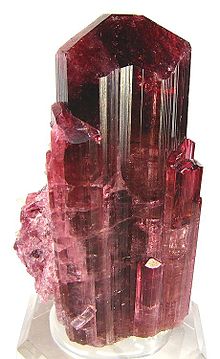Mineral
.mw-parser-output .hidden-begin{box-sizing:border-box;width:100%;padding:5px;border:none;font-size:95%}.mw-parser-output .hidden-title{font-weight:bold;line-height:1.6;text-align:left}.mw-parser-output .hidden-content{text-align:left}You can help expand this article with text translated from
the corresponding article in Italian. (October 2021) Click [show] for important translation instructions.
Consider
adding a topic to this template: there are already 3,021 articles in the
main category, and specifying|topic= will aid in categorization.
Do not translate text that appears unreliable or low-quality. If possible, verify the text with references provided in the foreign-language article.
You must provide
copyright attribution in the
edit summary accompanying your translation by providing an
interlanguage link to the source of your translation. A model attribution edit summary is Content in this edit is translated from the existing Italian Wikipedia article at [[:It:Rubellite]]; see its history for attribution.
You should also add the template ((Translated|It|Rubellite)) to the
talk page.
For more guidance, see
Wikipedia:Translation.
| Rubellite |
|---|
 |
|
| Category | Tourmaline[1] |
|---|
|
| Color | Red, pink, pinkish, violet-red |
|---|
Rubellite is the red or pink variety of tourmaline and is a member of elbaite. Rubellite is also the rarest gem in its family.[2] It is occasionally mistaken for ruby.[3] These gems typically contain inclusions.[4]
Notable countries where rubellite can be mined include Afghanistan, Brazil, Madagascar, Myanmar, Nigeria, Russia, and the United States.[4]
Name
Rubellite is named after the Latin word rubellus, meaning "reddish".[2] The word rubellite was first used in the year 1794.[5]
The gem is also called aphrite, apyrite, rubelite, or rubylite.[1]
History
Rubellite crystals were known in Europe when specimens were imported from the East as early as Roman times, however these rubellite specimens were confused with other red gemstones, such as some garnets and spinels.[6]
Value
Rubellite is the most expensive and prized gem in the tourmaline group.[7] The most valuable specimens are colored red and lack brown.[3] Those that are of ruby color are the most valuable.[8]
